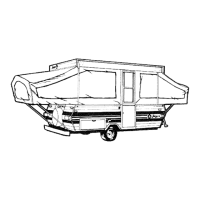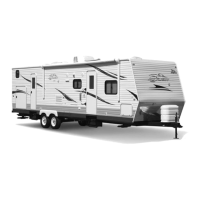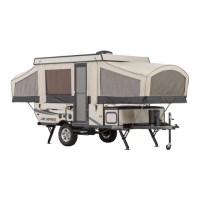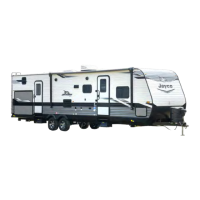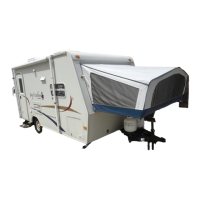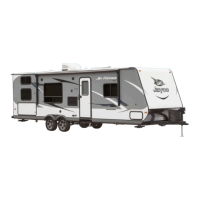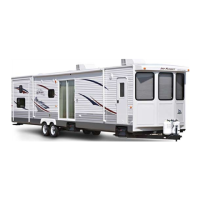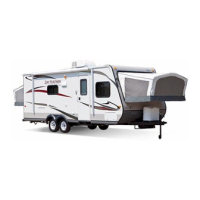SECTION 4
TOWING & HANDLING
36
CAMPING TRAILER
H
ITCHING PROCEDURE
Hooking up a camping trailer will become
easier with practice. The following procedure
will help until you become more experienced.
1. Make sure the trailer wheels are blocked.
2. Turn the tongue jack crank to raise the
travel trailer tongue above the hitch ball.
3. Open the coupler latch on the travel trailer
hitch.
4. Back the tow vehicle into the proper
position.
5. Turn the tongue jack crank to lower the
coupler onto the hitch ball.
6. Close the coupler latch after it is
completely seated.
7. Install the (customer supplied) weight
distributing bars (equalizers) as directed
by the OEM.
8. Remove the dolly wheel or platform and
retract the tongue jack to its maximum
height.
9. Attach the breakaway switch cable to the
tow vehicle.
10. Walk around the RV to verify exterior
lights are working correctly.
11. Attach the safety chains.
12. Plug in your wire harness/connector plug
from the tow vehicle to the travel trailer.
13. Remove the trailer wheel blocks.
If an Atwood brake actuator is used with an
equalizing hitch, be sure the hanger chains
hang between straight down and forward up
to 34°. Do not use less than 6-1/2” hanger
chain length. For optimum brake
performance, hang chains forward 34°. Refer
to OEM manual for more information.
TOWING
You will find that your RV will travel safely and
comfortably at most posted trailer highway
speed limits. However, it will take longer than
a passenger automobile to reach that speed.
Keep this in mind when overtaking and
passing another vehicle. Allow more time to
go around the vehicle you are passing. You
cannot cut back into the traffic lane as quickly
due to the longer length of your tow
vehicle/RV combination. Drive with caution to
avoid situations that might require quick
momentum changes.
Even though your RV is equipped with brakes
designed for GVWR, we suggest practicing
stopping away from traffic until you become
accustomed to your RV’s stopping distance. A
good way to practice is at a large parking lot
(where it is permissible). Easing to a stop and
starting smoothly saves wear and tear on
your tow vehicle/RV combination.
Drive defensively, try to anticipate problems
that may occur and prepare for them (even if
they may never happen). Be aware of road
surface conditions. Slow down well in
advance of dips and bumps to reduce the
jolting to your tow vehicle/RV combination.
Drive over them slowly and let the trailer tires
pass over them before accelerating. Cross
railroad tracks slowly (always release your
brakes before crossing).
When descending a long hill, drop down into
a lower gear (or lower range if you have
automatic transmission). Avoid conditions that
Your RV braking system is rated for
operation at GVWR not
GCWR.
Whenever possible, do not travel with
waste in the holding tanks. Liquid or debris
in the holding tank(s) may affect the towing
characteristics and may result in property
damage or personal injury.
